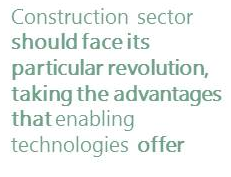
Public initiatives like ‘Connected Industry 4.0’ are developing measures that allow the industrial fabric to benefit from the intensive use of ICT in all areas of its activity. These initiatives are linked to the term Industry 4.0, which refers to the challenge of carrying out the 4th Industrial Revolution through the transformation of industrial sector by the enabling technologies incorporation: 3D printing, robotization, sensors and embedded systems, augmented reality, artificial vision, predictive maintenance, cybersecurity, traceability, big data, etc.
Construction sector, as the industrial one, is immersed in a deep metamorphosis before the irruption of these new technologies. The economic crisis has been very intense in this market. As a strategy for its recovery, it must its particular revolution, taking full advantage of the opportunities offered by enabling technologies. For this reason, the ‘Construction 4.0’ concept appears as a necessity to digitize the construction through the incorporation of enabling technologies adapted to their particularities.
In this sector, it is the first time that a revolution is built ‘a priori’, which gives us the opportunity both to companies and to research centres to participate actively in the future.
In CARTIF, we work along this line by means of some projects that apply these technologies. In the case of the BIM (Building Information Modeling), which proposes to manage the complete cycle of the project through a digital 3D model, we develop improvements to include all the actor of the value chain.

With reference to 3D printing, a methodology that allows the construction of objects layer by layer, obtaining singular pieces or with complex geometries, CARTIF applies technologies to the direct printing on vertical surfaces for the rehabilitation of facades.
If we talk about robotization, besides the fact that making specific robots to certain tasks, adapt existing machines increasing their autonomy and safety of operators. In this line, we collaborate to develop monitoring and navigation technologies for the automatic guidance of machinery and to detect risks situations between machinery and operators.
With all these innovations, the future of construction is promising, if and when this research would be considered as an essential basis for its growth.
- Digitizing the construction to prepare the future - 4 May 2017
- Curie vs Tesla? Autonomous sensors embedded in the pavement - 31 January 2017
- Safety in collaborative robotics - 27 June 2016
